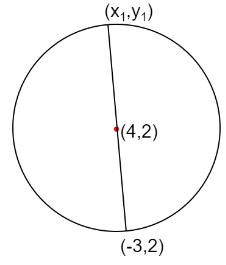
If one end of the diameter of the circle ${x^2} + {y^2} - 8x - 4y + c = 0$ is $\left( { - 3,2} \right)$then other coordinate is
A. $\left( {5,3} \right)$
B. $\left( {6,2} \right)$
C. $\left( {1, - 8} \right)$
D. $\left( {11,2} \right)$
Answer
216.6k+ views
Hint: In this question, we are given a equation of circle ${x^2} + {y^2} - 8x - 4y + c = 0$ and the coordinate of one end of its diameter and we have to find the other end. First step is to calculate the center points by comparing the given equation with the standard form of the equation of circle. Then, apply the mid-term formula.
Formula Used:
The general form of the equation of circle is ${x^2} + {y^2} + 2gx + 2fy + c = 0$ whose center is $\left( { - g, - f} \right)$
Midpoint formula $\left( {x = \dfrac{{{x_1} + {x_2}}}{2},y = \dfrac{{{y_1} + {y_2}}}{2}} \right)$ where $\left( {x,y} \right)$ is the coordinate of midpoint and $\left( {{x_1},{y_1}} \right)$, $\left( {{x_2},{y_2}} \right)$ are the coordinates of the end points of the line.
Complete step by step solution:
Given that,
The coordinate of one end of the diameter of the circle ${x^2} + {y^2} - 8x - 4y + c = 0$ is $\left( { - 3,2} \right)$.

Image: Circle
Compare the above equation with ${x^2} + {y^2} + 2gx + 2fy + c = 0$whose center is $\left( { - g, - f} \right)$
It implies that, the center of the circle is at $\left( {4,2} \right)$
Now, the coordinate of the diameter of one end is $\left( { - 3,2} \right)$
Let, the coordinates of other end be $\left( {{x_1},{y_1}} \right)$
Using midpoint formula,
$\dfrac{{{x_1} - 3}}{2} = 4,\dfrac{{{y_1} + 2}}{2} = 0$
$ \Rightarrow {x_1} = 11,{y_1} = 2$
The coordinate of the other point are $\left( {11,2} \right)$
Option ‘D’ is correct
Note: To solve such a question, first try to make the figure and understand the question properly. One should always remember each and every equation of the circle (General and standard both). Also, if the line is divided in two equal halves and any two coordinates are given, always apply a mid-term formula to find the third coordinate.
Formula Used:
The general form of the equation of circle is ${x^2} + {y^2} + 2gx + 2fy + c = 0$ whose center is $\left( { - g, - f} \right)$
Midpoint formula $\left( {x = \dfrac{{{x_1} + {x_2}}}{2},y = \dfrac{{{y_1} + {y_2}}}{2}} \right)$ where $\left( {x,y} \right)$ is the coordinate of midpoint and $\left( {{x_1},{y_1}} \right)$, $\left( {{x_2},{y_2}} \right)$ are the coordinates of the end points of the line.
Complete step by step solution:
Given that,
The coordinate of one end of the diameter of the circle ${x^2} + {y^2} - 8x - 4y + c = 0$ is $\left( { - 3,2} \right)$.

Image: Circle
Compare the above equation with ${x^2} + {y^2} + 2gx + 2fy + c = 0$whose center is $\left( { - g, - f} \right)$
It implies that, the center of the circle is at $\left( {4,2} \right)$
Now, the coordinate of the diameter of one end is $\left( { - 3,2} \right)$
Let, the coordinates of other end be $\left( {{x_1},{y_1}} \right)$
Using midpoint formula,
$\dfrac{{{x_1} - 3}}{2} = 4,\dfrac{{{y_1} + 2}}{2} = 0$
$ \Rightarrow {x_1} = 11,{y_1} = 2$
The coordinate of the other point are $\left( {11,2} \right)$
Option ‘D’ is correct
Note: To solve such a question, first try to make the figure and understand the question properly. One should always remember each and every equation of the circle (General and standard both). Also, if the line is divided in two equal halves and any two coordinates are given, always apply a mid-term formula to find the third coordinate.
Recently Updated Pages
JEE Atomic Structure and Chemical Bonding important Concepts and Tips

JEE Amino Acids and Peptides Important Concepts and Tips for Exam Preparation

Electricity and Magnetism Explained: Key Concepts & Applications

Chemical Properties of Hydrogen - Important Concepts for JEE Exam Preparation

JEE Energetics Important Concepts and Tips for Exam Preparation

JEE Isolation, Preparation and Properties of Non-metals Important Concepts and Tips for Exam Preparation

Trending doubts
JEE Main 2026: Application Form Open, Exam Dates, Syllabus, Eligibility & Question Papers

Derivation of Equation of Trajectory Explained for Students

Hybridisation in Chemistry – Concept, Types & Applications

Understanding the Angle of Deviation in a Prism

Understanding Collisions: Types and Examples for Students

How to Convert a Galvanometer into an Ammeter or Voltmeter

Other Pages
JEE Advanced Marks vs Ranks 2025: Understanding Category-wise Qualifying Marks and Previous Year Cut-offs

NCERT Solutions for Class 11 Maths Chapter 10 Conic Sections

NCERT Solutions for Class 11 Maths Chapter 9 Straight Lines

NCERT Solutions For Class 11 Maths Chapter 8 Sequences And Series

Understanding Atomic Structure for Beginners

NCERT Solutions For Class 11 Maths Chapter 12 Limits And Derivatives




